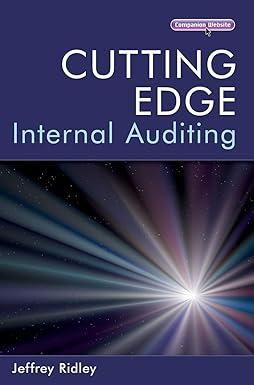Question
Use T-accounts to record the 4 months of transactions noted below for this new start-up company . Record all entries affecting the income statement into
Use T-accounts to record the 4 months of transactions noted below for this new start-up company. Record all entries affecting the income statement into Equity since there are no separate T-accounts set up for the individual income statement accounts. Once all transactions have been posted, populate the net ending balance for each account for the accounts listed below.
Month 1:
$2,000,000 sale of stock occurs with all cash received by the company
$3,000,000 bank loan received from the companys bank at the end of the month interest will start accruing next month (interest rate is 1% per month). Principal and interest cash payments will be made in a lump-sum payment at the end of the loan period.
Factory is leased at the beginning of the month and prepaid for the entire year up-front at a cost of $720,000. The first month of lease expense is expensed to the income statement now.
$2,400,000 investment in factory equipment is made. Total purchase price is payable in 30 days. Equipment will be depreciated on a straight line basis over 10 years. First month of depreciation expense is recorded now.
Business insurance with coverage for the upcoming year is purchased at the beginning of the month at a cost of $360,000. The policy is prepaid for at the time of purchase. The first month of insurance expense is charged to the income statement now.
$800,000 of inventory is received and will be paid to the suppliers in 30 days.
Month 2:
$550,000 in sales are recorded on 30-day terms. The cost of the product sold is $500,000.
Payment for factory equipment purchased in month 1 is made.
Payment for inventory purchased in month 1 is made.
Additional inventory valued at $500,000 is made. The supplier requires a 50% down payment at the time of inventory receipt with the remaining 50% due within 30 days.
A bad debt reserve of $20,000 is created/recorded since some of the amounts in accounts receivable will no longer be collectible.
2nd month of depreciation expense is recorded.
2nd month of prepaid insurance expense is recorded.
2nd month of prepaid lease expense is recorded.
The first month of interest expense related to the bank loan received during month 1 is accrued.
Month 3:
$800,000 is sold to customers on 30-day terms. The cost of the product sold is $800,000.
3rd month of depreciation expense is recorded.
3rd month of prepaid insurance expense is recorded.
3rd month of prepaid lease expense is recorded.
Payment for inventory purchased in month 2 is made. An additional $300,000 of inventory is purchased from the same supplier with the supplier requiring a 50% down payment at the time of inventory receipt and the remaining 50% due within 30 days.
An additional bad debt reserve of $25,000 is created/recorded since additional outstanding accounts receivables have been determined to no longer be collectible.
Payment for 90% of the receivables generated during month 2 is received.
The second month of interest expense related to the bank loan received during month 1 is accrued.
Month 4:
4th month of depreciation expense is recorded.
4th month of prepaid insurance expense is recorded.
4th month of prepaid lease expense is recorded.
$600,000 is sold to customers. The cost of the product sold is $400,000. 50% of the sales are paid for at time of delivery to customer with the remainder due within 30 days.
Payment for inventory purchased on terms in month 3 is made. An additional $200,000 of inventory is purchased from the same supplier with payment due within 30 days.
$25,000 of inventory has been discovered to be obsolete with no market value whatsoever. The entire amount is scrapped and written off during this month.
Payment for 5% of the receivables generated during month 2 and 90% of the receivables generated during month 3 is received.
The third month of interest expense related to the bank loan received during month 1 is accrued.
A $20,000 dividend is paid during month 4 to shareholders.
Note: A T-account table is provided for you to use to answer this question in Blackboard. After working through the T-accounts, the net balances for each of the Balance Sheet accounts listed below must be populated/answered:
Cash
Net Receivables
Inventory
Prepaid Expenses
Property, Plant, & Equipment
Total Assets
Accounts Payable
Debt
Stockholders' Equity
Total Liabilities & Stockholders' Equity
Step by Step Solution
There are 3 Steps involved in it
Step: 1

Get Instant Access to Expert-Tailored Solutions
See step-by-step solutions with expert insights and AI powered tools for academic success
Step: 2

Step: 3

Ace Your Homework with AI
Get the answers you need in no time with our AI-driven, step-by-step assistance
Get Started


